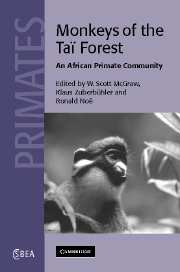Book contents
9 - Positional behavior and habitat use of Taï forest monkeys
Published online by Cambridge University Press: 30 July 2009
Summary
Introduction
Locomotion and posture are important elements of behavioral ecology. Since primates are mobile and most are arboreal, knowing where, why, and how they position themselves in the forest canopy provides a better understanding of many aspects of primate life. Establishing predictive relationships between positional behavior and additional aspects of primate biology not only helps explain the behavior of living animals, but also allows us to infer the behavior of fossil taxa more reliably. Although there have been many studies of one or a few species at single sites, studies of positional behavior of whole (or nearly whole) primate communities are rare. Notable exceptions include the landmark study of Fleagle and Mittermeier (1980) on monkeys in Surinam and the study by Gebo and Chapman (1995a, 1995b) on monkeys in Uganda's Kibale Forest. In an effort to add to the body of comparative data, I began studies on the positional behavior of seven Taï Forest monkeys in 1993. The first study of Taï monkeys by Galat and Galat-Luong (1985) contained basic data on habitat use, however these authors were not primarily concerned with positional behavior.
The monkeys at Taï provide a potentially stringent test of what determines – or at least co-varies with – locomotion and posture. Unlike the Surinam monkeys studied by Fleagle and Mittermeier (1980), the Taï cercopithecids do not represent a great diversity of locomotor adaptations or as great a range of body size (Schultz 1970, Oates et al. 1990, Fleagle 1999).
- Type
- Chapter
- Information
- Monkeys of the Taï ForestAn African Primate Community, pp. 223 - 254Publisher: Cambridge University PressPrint publication year: 2007
References
- 12
- Cited by

